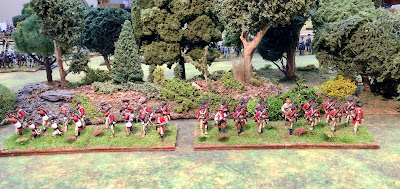 |
| British Loyalist regiment of 24 figures, Fife and Drum Miniatures |
I recently finished a regiment of Loyalists wearing red coats to use in the various theaters of the American Revolutionary War. I used a mix of figure packs for American militia, armed civilians and some British light company figures (with bayonets clipped off).
The figures can be used as either a 32 figure regiment with 8 figures per stand, or as two small regiments of 16 figures. I use a figure to man ratio of 1:10 so the Loyalist regiment could be 320 men or two regiments of 160 men.
 |
| Two stands of advancing Loyalists. Fife and Drum Miniatures |
 |
| Two stands of Loyalists in firing poses. Fife and Drum Miniatures |
I painted two stands of figures in a firing line and two stands of figures advancing so if I want to break the unit down into two 16 figure regiments, then they can be easily delineated from each other by the type of pose in the unit.
 |
| Both sections of the Loyalist regiment Fife and Drum Miniatures |
For the basing, I tried out a method of using two different heights of static grass: 4mm and 7mm. This is a method used by model railroaders and I am pleased with the way that the basing turned out.
As I usually do, I use a mixture of light wall board paste (Red Devil or DAP brands) and brown acrylic paint that I purchase at Michael's Stores. By the way, make sure that you purchase the "light" spackle and not the "heavy spackle". You will know the difference when you pick of the container, believe you me.
I stir the brown paint into the pint or quart plastic container of spackle, add just a touch of water to thin it down, and then start stirring the mixture with a spoon until the mix looks like chocolate pudding. You can use different color paints if you wish. For example, I keep a container of light tan goop on hand that I use to make dirt roads.
The goop is then spread around the base and pushed between the feet of the figures using a small artists' spatula. Sometimes a touch of water is added to thin down the goop, which makes it easier to trowel around the figures on the base. While the goop is still wet, I place it in a container of fine railroad ballast from Woodland Scenics and let the base dry overnight. The next day I do a little bit of dry brushing with a contrasting color of paint and then I start affixing tufts of grass, maybe some flowers and then static grass. I like to keep a few brown patches on the base to depict dirt and to break up the solid mass of static grass. For this Loyalist unit, I used the two different heights of static grass for the first time.
And finally, here is a picture of a test piece of small terrain board:
This board measures 16" by 8" and is meant to be used with a small farm in Europe or North America. I am not planning on making large terrain boards for my games. The Cigar Box mats work just fine.
cc








This unit is a nice addition. I also like the rocky woodland piece behind the soldiers.
ReplyDeleteStephen
Cracking looking unit/units, they look great, like the idea of mixing some militia in with the regular uniforms gives a really nice irregular look the the unit. You don't see too many loyalist units so this is a wee treat.
ReplyDeleteOutstanding looking regiment! I really like your basing for this regiment and how flexible it is.
ReplyDelete